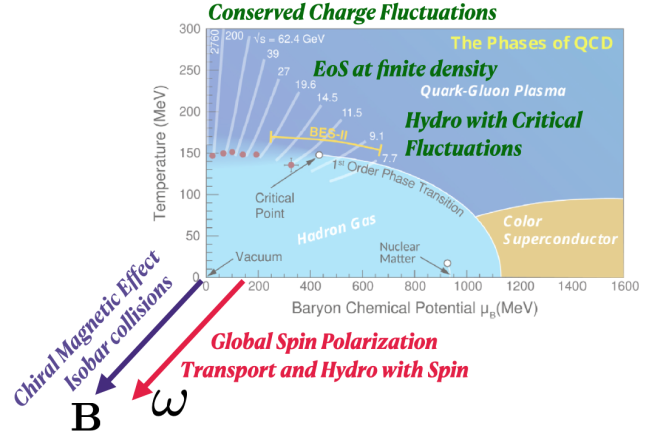INT 20-1c Highlights Report
Chirality and Criticality: Novel Phenomena in Heavy-Ion Collisions
May 11 - 22, 2020
J. Liao, M. Stephanov, Z. Xu, H.-U. Yee

The hot dense strong-interaction matter created in heavy ion collisions provides a unique laboratory for exploring a number of novel phenomena, which have triggered enthusiastic interests recently. One focal point of the field is the search of long-sought-after critical end point (CEP) as well as scanning the related phase boundaries on the QCD phase diagram. There have been significant developments in this direction by studying the conserved charge fluctuations, equation of state at finite density as well as hydrodynamics with critical fluctuations, which are schematically highlighted in the figure. Another topic concerns the physics of chirality in QCD that can be manifested by the presence of a strong magnetic field through the anomalous transport processes such as the Chiral Magnetic Effect (CME). Furthermore, there have been considerable interests in exploring properties of QCD matter under new extreme conditions such as strong magnetic field and fluid vorticity. These open up new dimensions to the conventional QCD phase diagram, as illustrated by the arrows in the figure. Notable progress has been achieved in a number of topics (as also indicated in the figure) such as the CME, global and local spin polarization, as well as transport and hydrodynamic frameworks with spin degrees of freedom. Very active experimental efforts have been ongoing in looking for these phenomena in laboratory, including the isobaric collision experiment for the search of CME as well as the Beam Energy Scan II (BES II) experiment for the search of CEP, both of which are demonstrated in the figure.
The 2-week virtual program hosted a total of 33 speakers (15 in the first week and 18 in the second). These talks reviewed the current status and discussed the future prospect in measuring and understanding these novel phenomena. Notably, the program witnessed a diverse range of recent progress with many newest theoretical and experimental results on the topics highlighted in the figure, which provides only a glimpse into the scientific talks and vibrant exchanges at the program. The successful program was strongly indicative of rapid further developments along these lines of inquiry in the next several years, with very important results expected to emerge soon.
